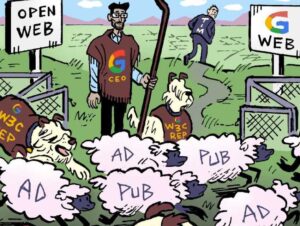Challenger Approaching
Omnicom’s impending acquisition of IPG would create the world’s largest agency holdco – and Publicis is just fine with that.
Although Publicis stands to lose its No. 1 status, Chairman and CEO Arthur Sadoun tells Ad Age that he’s happy to embrace a “challenger position” and capitalize on the potential fallout from the likely “three years of restructuring” it’ll take Omnicom and IPG to complete their merger.
In the meantime, Publicis is in a pretty solid position, per its earnings report on Tuesday. The company generated $14.5 billion in revenue last year and increased its organic revenue by 5.8% globally and 4.9% in the US year-over-year.
For 2025, Publicis forecasts to grow between 4% and 5% and is committed to “doubling down on new business and talent, which will likely involve poaching more ex-Omnicom folks. Several top Omnicom execs have already left, including Geoff Calabrese (now chief commercial officer of Publicis Groupe) and Matt McNally (now global CEO of Publicis Health and no relation to our associate editor Victoria McNally).
Publicis also intends to invest between $830 million and $930 million in AI, in addition to the $12 billion it’s spent since 2015. That’ll likely take the form of M&A, although probably nothing as major as what Omnicom and IPG are attempting.
Head In The Clouds
Welcome to the quantum entanglement of Google’s cloud infrastructure business and Google Cloud Platform (GCP) with its core advertising technology.
Within Google, there’s “been a flow of advertising salespeople into Google Cloud, lured by the promise of bigger commissions and more opportunities for promotion,” The Information reports. GCP and Google Ads salespeople are also working more closely together on customer deals.
One reason for this new intimacy is the growth of AI-based ad products, which are tied to cloud bandwidth consumption. And don’t forget about Ads Data Hub (ADH), Google’s cloud-based ad analytics hub and home to its data clean room services.
ADH is great for juicing up CRM info from Google’s own audience graph. But that data never leaves GCP. An advertiser might develop what feels like its own unique, first-party database, but if they were to ditch the Google Cloud, they’d leave with only the raw data that was added to the system – no additions or adornments.
Not to mention that some advertising features, such as targeting ads by first-party sales data, now require Google Cloud storage, according to The Information.
“What is sort of new is very much a more conjoined ads plus cloud conversation,” says Will Heins, a partner at Jellyfish, The Brandtech Group’s digital marketing agency and a Google Cloud partner.
Spot Check
Spotify’s ad business is growing – but not as quickly as some investors would like.
During the company’s Q4 earnings call on Tuesday, CFO Christian Luiga pointed to ad revenue growth of 6% year over year. He added that Spotify saw “some early positive progress in our automated sales efforts,” likely from the launch of its supply-side platform SAX in October.
However, investors questioned why Spotify’s ad revenue isn’t keeping pace with audience growth. Spotify reported a 12% YOY bump in monthly active users in Q4, bringing total MAUs to 675 million. The majority are in the ad-supported tier, while 263 million are ad-free subscribers.
In response, Luiga said the ad business needs time to grow. For example, Spotify is shifting to focus more on performance campaigns rather than brand campaigns, which Luiga acknowledged was a market shift the company was late to embrace.
Plus, it’s early days for Spotify’s programmatic business, which is centered on high-demand video inventory, Luiga said.
Until recently, Spotify focused on direct sales. But the new SSP and its recent partnership with The Trade Desk should help Spotify attract more programmatic demand this year, Luiga said.
“2025 will be the year of building,” he said, “and 2026 is when we think we’re going to get scale.”
But Wait! There’s More
Havas has acquired ecommerce and retail media agency Channel Bakers. [Adweek]
AppsFlyer lays off 7% of its workforce with an IPO on the horizon. [Globes]
Cloudflare CEO Matthew Prince says search and generative AI web crawlers can no longer justify scraping sites by sending back increasingly anemic referral traffic. Instead, Cloudflare is considering making them pay for access to sites. [Fortune]
Books full of AI slop have already made their way into public libraries. [404 Media]
LinkedIn rolled out new vertical video and analytics tools to support a big uptick in video content being uploaded to its platform. [TechCrunch]
You’re Hired
Warner Bros. Discovery names Ryan Gould and Bobby Voltaggio as its new presidents of US ad sales. [Adweek]
Outfront Media names Nick Brien as interim CEO. [release]
Thanks for reading AdExchanger’s daily news round-up… Want it by email? Sign up here.















